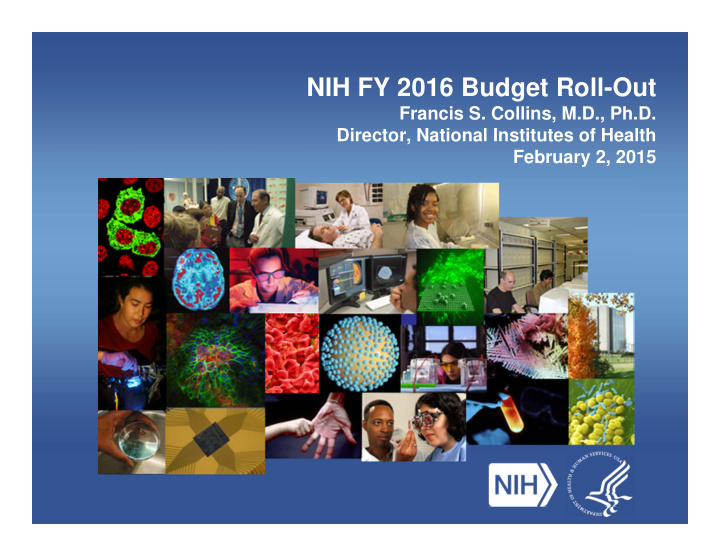



NIH FY 2016 Budget Roll-Out Francis S. Collins, M.D., Ph.D. Director, National Institutes of Health February 2, 2015
NIH’s FY 2016 Budget Request FY 2016 Year FY 2014 FY 2015 Request Program Level ($B) $30.070 $30.311 $31.311 Competing RPGs (est.) 9,168 9,076 10,303 Total RPGs (est.) 34,332 34,206 35,447 Applicant Success Rate (est.) 18.0% 17.2% 19.3% The proposed increase of $1 billion in FY 2016 would allow over 1,200 more new and competing Research Project Grants NIH also received $238 million of emergency appropriations for Ebola research in FY 2015 (not included above)
FY 2016 Request: Highlights of Targeted Increases Precision Medicine Initiative $200 M – Cancer 70 M – Other Diseases 130 M Antimicrobial Resistance 100 M BRAIN Initiative 70 M Alzheimer’s Disease 50 M
“And that’s why the budget I send this Congress on Monday will include a new Precision Medicine Initiative that brings America closer to curing diseases like cancer and diabetes, and gives all of us access, potentially, to the personalized information that we need to keep ourselves and our families healthier.” President Barack Obama January 30, 2015
www.nih.gov/precisionmedicine
Precision Medicine Initiative: Near Term Apply tenets of precision medicine to cancer Identify new cancer subtypes, therapeutic targets Test precision therapies, with private sector partners – Wide spectrum of adult and pediatric cancers – Early stage to advanced disease Expand understanding of therapeutic response – Drug resistance – Combination therapy – Predicting and monitoring tumor recurrence
Precision Medicine Initiative: Longer Term Generate knowledge base needed to move precision medicine into the whole range of health and disease To reach this goal, the Initiative will support: – Creative approaches for detecting, measuring, analyzing wide range of biomedical data: molecular, genomic, cellular, clinical, behavioral, physiological, and environmental – Tests of these innovations in small, pilot studies – Evaluation of most promising approaches in greater numbers of people over longer periods of time
Precision Medicine Initiative National Research Cohort – >1 million U.S. volunteers – Numerous existing cohorts (many funded by NIH) – New volunteers Participants will be centrally involved in design and implementation of the cohort They will share genomic data, lifestyle information, biological samples – all linked to their electronic health records
Precision Medicine Initiative The National Research Cohort will: Provide scientists with a ready platform for: – Observational studies of drugs and devices – Tests of wearable sensors for monitoring health – More rigorous interventional studies Forge new model for “doing science” that emphasizes engaged participants and open, responsible data sharing with privacy protections
Other Extraordinary Opportunities for FY 2016 Unraveling Life’s Mysteries through Basic Research Translating Discovery into Health Preparing a Diverse and Talented Biomedical Research Workforce
Unraveling Life’s Mysteries through Basic Research: The BRAIN Initiative Last September, NIH’s made its first investment in the Initiative’s 12-year scientific vision with 58 awards FY16 request totals $135 M – increase of $70 M Funding will be used to: – Develop innovative technologies to advance basic neuroscience – Generate methods for classifying the brain’s diverse cells/circuits – Create/optimize technologies for recording and modulating groups of cells that act together in circuits – Develop new, non-invasive tools for human brain imaging
Translating Discovery into Health: New Strategies in Battle Against AMR Announced September 18, National Strategy for Combating Antibiotic-Resistant Bacteria (basis for $100 M proposed increase in FY16) Research recommendations include: – National database of genomic sequences of antibiotic resistant microbes that cause human infections – Better diagnostics; NIH/BARDA will offer $20 M prize – New antibiotics and vaccines – National clinical research network, building on the efforts of NIH Antibacterial Resistance Leadership Group
Translating Discovery into Health: Alzheimer’s Disease, Accelerating Medicines Major investment in Alzheimer’s disease (AD) research FY16 request totals $638 M – increase of $50 M – Basic research in neuroscience – Epidemiologic studies to identify risk and protective genes – Clinical studies for early diagnosis and progression; >25 trials Accelerating Medicines Partnership (AMP) – First projects: AD, type 2 diabetes, lupus, rheumatoid arthritis – FY16 request totals $23 million, same as FY15
Preparing a Diverse & Talented Biomedical Research Workforce To encourage the next generation of scientists, NIH will continue to invest in: High-Risk High-Reward Program to support innovative researchers with potentially transformative goals Early Independence Awards to enable exceptional junior scientists to “skip the postdoc” An array of programs to enhance diversity in the biomedical research workforce
And Much More … Microbiome – Susceptibility to obesity, heart disease, other conditions? – Efforts to improve health by adjusting microbiome Stem Cell Technology – “You on a Chip” – Regenerative medicine Vaccines – Ebola, other emerging diseases – Universal flu vaccine – HIV/AIDS – more promise than ever
The 21st century is the century of biology. The nation that invests in biomedical research will reap untold rewards in its economy and the health of its people.
NIH … Turning Discovery Into Health directorsblog.nih.gov @NIHDirector
Recommend
More recommend